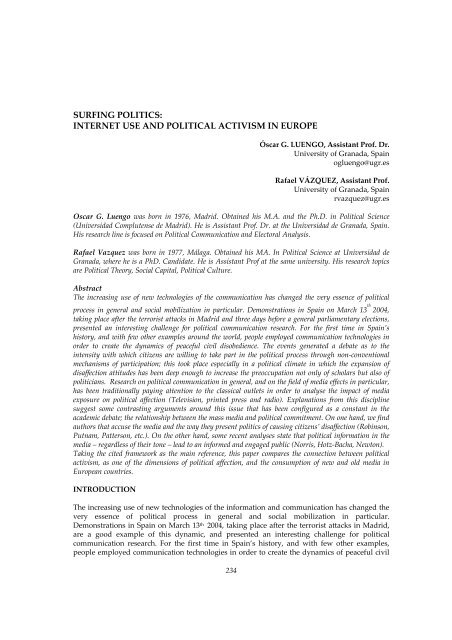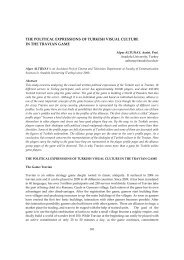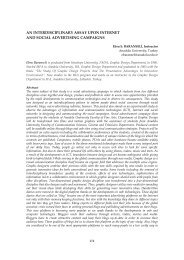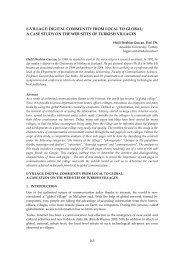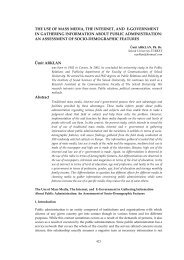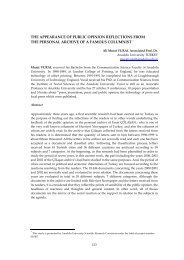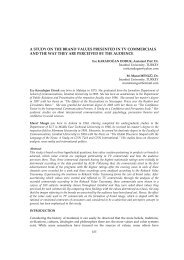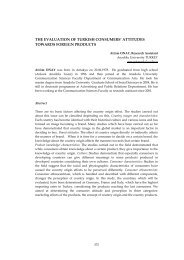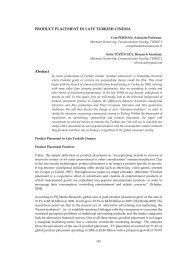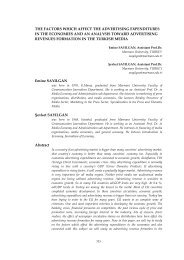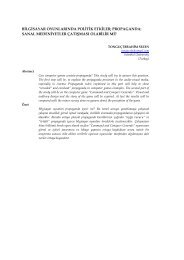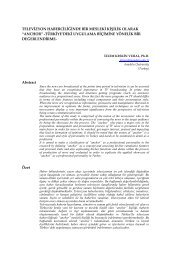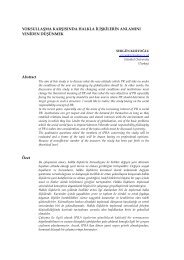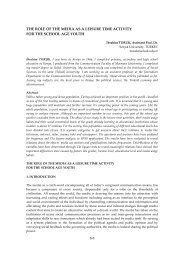SURFING POLITICS: INTERNET USE AND POLITICAL ACTIVISM ...
SURFING POLITICS: INTERNET USE AND POLITICAL ACTIVISM ...
SURFING POLITICS: INTERNET USE AND POLITICAL ACTIVISM ...
You also want an ePaper? Increase the reach of your titles
YUMPU automatically turns print PDFs into web optimized ePapers that Google loves.
<strong>SURFING</strong> <strong>POLITICS</strong>:<br />
<strong>INTERNET</strong> <strong>USE</strong> <strong>AND</strong> <strong>POLITICAL</strong> <strong>ACTIVISM</strong> IN EUROPE<br />
234<br />
Óscar G. LUENGO, Assistant Prof. Dr.<br />
University of Granada, Spain<br />
ogluengo@ugr.es<br />
Rafael VÁZQUEZ, Assistant Prof.<br />
University of Granada, Spain<br />
rvazquez@ugr.es<br />
Oscar G. Luengo was born in 1976, Madrid. Obtained his M.A. and the Ph.D. in Political Science<br />
(Universidad Complutense de Madrid). He is Assistant Prof. Dr. at the Universidad de Granada, Spain.<br />
His research line is focused on Political Communication and Electoral Analysis.<br />
Rafael Vazquez was born in 1977, Málaga. Obtained his MA. In Political Science at Universidad de<br />
Granada, where he is a PhD. Candidate. He is Assistant Prof at the same university. His research topics<br />
are Political Theory, Social Capital, Political Culture.<br />
Abstract<br />
The increasing use of new technologies of the communication has changed the very essence of political<br />
process in general and social mobilization in particular. Demonstrations in Spain on March 13 th<br />
2004,<br />
taking place after the terrorist attacks in Madrid and three days before a general parliamentary elections,<br />
presented an interesting challenge for political communication research. For the first time in Spain’s<br />
history, and with few other examples around the world, people employed communication technologies in<br />
order to create the dynamics of peaceful civil disobedience. The events generated a debate as to the<br />
intensity with which citizens are willing to take part in the political process through non-conventional<br />
mechanisms of participation; this took place especially in a political climate in which the expansion of<br />
disaffection attitudes has been deep enough to increase the preoccupation not only of scholars but also of<br />
politicians. Research on political communication in general, and on the field of media effects in particular,<br />
has been traditionally paying attention to the classical outlets in order to analyse the impact of media<br />
exposure on political affection (Television, printed press and radio). Explanations from this discipline<br />
suggest some contrasting arguments around this issue that has been configured as a constant in the<br />
academic debate; the relationship between the mass media and political commitment. On one hand, we find<br />
authors that accuse the media and the way they present politics of causing citizens’ disaffection (Robinson,<br />
Putnam, Patterson, etc.). On the other hand, some recent analyses state that political information in the<br />
media – regardless of their tone – lead to an informed and engaged public (Norris, Hotz-Bacha, Newton).<br />
Taking the cited framework as the main reference, this paper compares the connection between political<br />
activism, as one of the dimensions of political affection, and the consumption of new and old media in<br />
European countries.<br />
INTRODUCTION<br />
The increasing use of new technologies of the information and communication has changed the<br />
very essence of political process in general and social mobilization in particular.<br />
Demonstrations in Spain on March 13th 2004, taking place after the terrorist attacks in Madrid,<br />
are a good example of this dynamic, and presented an interesting challenge for political<br />
communication research. For the first time in Spain’s history, and with few other examples,<br />
people employed communication technologies in order to create the dynamics of peaceful civil
disobedience. The events generated a debate as to the intensity with which citizens are willing to<br />
take part in the political process through non-conventional mechanisms of participation; this<br />
took place especially in a political climate in which the expansion of disaffection attitudes has<br />
been deep enough to increase the preoccupation of academics.<br />
Many political scientists have called attention to this specific situation, which has considered<br />
quite concern among experts given the widespread feelings of low identification with the<br />
political process. Professionals, as well as scholars, have focused their efforts in understanding<br />
the complex developments through which we have derived in this particular guideline of<br />
conduct with respect to the public; the specific nature of these situations has to do with the low<br />
rates of political participation in general, with the negative evaluation of governmental<br />
performance, with a low degree of political knowledge and interest, and with an extended lack<br />
of identification with public institutions.<br />
The concept of political disaffection is having a lot of significance today since it is characterising<br />
specifically the general trend of contemporary western world’s political culture. This process is<br />
described basically by the combination of, by one hand, low levels of electoral turnout, of<br />
political participation, of political efficacy, of political knowledge, of political understanding,<br />
and, by the other hand, a firm approval of democratic principles, and has been pointed out as a<br />
potential component of political system’s instability.<br />
Social sciences in general, and political and media sciences specifically, have explored the causes<br />
of these behavioural patterns and have developed a theoretical framework to face this<br />
challenging phenomenon. The belief that the processes of political communication have<br />
substantially altered citizen’s political and civic engagement, to one way or the other, has<br />
become a constant conviction between scholars and journalists, especially in the North American<br />
context.<br />
Nevertheless, the development of political communication as a discipline suggests some<br />
contrasting explanations around the relationship between the mass media and political<br />
engagement. On one hand, we find some authors that accuse the media of “narcotizing” the<br />
citizens, who are increasingly less participative and less trusting political institutions and are, in<br />
the terms of Robert Putnam, disaffected democrats (Robinson, 1976; Patterson, 1994; Fallows,<br />
1996; Cappella & Jamieson, 1997; Putnam & Pharr, 2000; Putnam, 2000). On the other hand,<br />
some recent analyses state that the empirical evidence points out in an opposite direction (Holtz-<br />
Bacha, 1990; Newton, 1999; Norris, 2000).<br />
Research on political communication in general, and on the field of media effects in particular,<br />
has been traditionally paying attention to the classical outlets in order to analyse the connection<br />
mentioned before, that is, the impact of media exposure on political affection. However, as we<br />
have already revealed, the development of new media outlets, the Internet, has extended the<br />
possibilities of study. We can find a good example of this direction through the increasing<br />
number of research works that has been published lately that took into account the Internet<br />
(Wilkins, 2000; Uslaner, 2000; Norris and Sanders, 2001; Shah, Kwak and Holbert, 2001; Price,<br />
Goldthwaite, et. Al., 2003; Rusciano, 2003; Sherr and Jenkins, 2003; Lee and Chen, 2004<br />
Hence, the idea that is going to vertebrate this paper could be defined through some questions<br />
that are going to be formulated in the following lines: How is related the use of the Internet to<br />
the level of political disaffection? Is it playing a significant role in any of its specific dimensions?<br />
Are new media fostering the non-electoral forms of participation in politics?<br />
235
LITERATURE REVIEW<br />
Theories of Media Malaise<br />
The process by which the theories of media malaise were generated is somewhat imprecise.<br />
Without a doubt, we find the origins of these interpretations in the considerations of Kurt Lang<br />
and Gladys Lang (1966). They were the first to suggest that a connection existed between the<br />
proliferation of network news and the extension of these feelings of disconnection with the<br />
political process. From their point of view, the way the television covered the news of a political<br />
nature could affect the fundamental orientations of the electorate towards public institutions,<br />
including the government. Television broadcasts, they argued, accentuate the conflicting<br />
elements of the political process, which feeds the public cynicism. Nevertheless, “the Langs<br />
proved an isolated voice at the time, in large part because the consensus in political communication was<br />
that the mass media had only minimal effects on public opinion” (Norris, 2000: 5). As a result, a new<br />
set of reflections began gradually to question the dominant paradigm during the sixties. The<br />
idea that the mass media had more weight than had been thought previously began to be voiced<br />
by several publications; Paul Weaver, for example, assured that the television news formats<br />
fomented “detachment (at best) one of the cases or cynical rejection (at worse) toward the political<br />
institution of the nation” (Weaver, 1972: 74).<br />
Nevertheless, 1976 was a crucial year in the development and later consolidation of the theory of<br />
media malaise. During this year, Michael Robinson popularised the term videomalaise arguing<br />
that preferring television in contrast to newspapers as source of political information causes<br />
political disaffection. In order to explain the growth of videomalaise the author pointed out six<br />
interrelated factors: 1) the anomalous magnitude and shape of the television news audiences, 2)<br />
the public perceptions of the credibility of the networks, 3) the interpretative character of<br />
television news coverage, 4) the stress on negative elements of the television news reports, 5) the<br />
emphasis on the conflict and the violence in network reporting, and 6) the anti-institutional<br />
theme of news programs on television (Robinson, 1976: 426). All these elements came together to<br />
foment political disaffection, frustration, cynicism and malaise of the general public.<br />
This perspective, which became consolidated at the end of the eighties and the beginning of the<br />
nineties, makes special sense in the North American political context. Television news in the U.S.<br />
do, indeed, present political life in a more negative way than newspapers do (Robinson &<br />
Sheehan, 1983). Political disaffection in the U.S. increases parallel to an increase in negative news<br />
stories about politicians and political institutions in American television (Lichter & Amundson,<br />
1994) but also newspapers (Patterson, 1993). Thus, the main studies that provided theoretical<br />
strength to the positions of media malaise in the North American context focused rather on the<br />
negative media content in general than on differences between television and newspapers<br />
(Patterson, 1993; Schudson, 1995; Fallows, 1996; Cappella and Jamieson, 1997). In summary, the<br />
theories of media malaise maintain two central assumptions: 1) the processes of political<br />
communication via mass media have a significant impact on the civic engagement of the<br />
citizens; 2) this impact takes shape in a negative direction or, in other words, the lack of social<br />
commitment towards the political process is determined by the process of political<br />
communication.<br />
Theories of Political Mobilization<br />
The position presented before is modified by a set of scientific works whose results have been<br />
grouped under the label of theories of political mobilization. Even though these new<br />
interpretations do not eliminate all the previous contributions, they propose substantial nuances<br />
that question the central argumentation of the videomalaise. In other words, they suggest that<br />
contemporary mass media have a significant impact on the public – this point is shared with the<br />
236
media malaise position – but this influence is produced in a positive direction, that is to say,<br />
maintaining and promoting democratic participation.<br />
The theories of political mobilization appear on the academic scene with a great influence in the<br />
nineties (Holtz-Bacha, 1990; Norris, 1996; Newton, 1999; Norris, 2000), right after the publication<br />
of some research conclusions. We could say that the first works in this line arise as a result of the<br />
contrast of the media malaise hypotheses. To some extent, this interpretation considers that by<br />
simply differentiating some analytical categories we can conclude that the media malaise<br />
theories are not strictly applicable as they were formulated. Fundamentally, mobilization<br />
theories underline that “we need carefully to disentangle the positive and negative effects of different<br />
media, messages, audiences and effects” (Norris et al., 1999: 99). In this sense, for example, the group<br />
of regular consumers of television news and habitual readers of political press are – regardless<br />
of tone of media coverage – more inclined to be informed, interested and committed to political<br />
life. On the contrary, citizens exposed to sensationalist contents usually present significant levels<br />
of political disaffection, cynicism and alienation.<br />
Finally, it is vital to mention the importance of a theory that, although framed within the<br />
theories of the mobilization, acquires a special status, since its considerations entail significant<br />
advances with respect to the general assumptions; the theory of the Virtuous Circle (Norris,<br />
2000). In spite of proposing a similar perspective to the contributions of the theory of political<br />
mobilization and objecting to the conclusions of the media malaise, the theory of the virtuous<br />
circle, stated by Pippa Norris, goes one step further and provides a more complete theoretical<br />
elaboration. As a result of the examination of empirical evidence derived from data analysis of<br />
the United States and Western Europe, one of the main assumptions of this theory resides in the<br />
following statement: the attention to the news in general is not configured as a factor that<br />
contributes to the erosion of the support for the political system. On the contrary, those<br />
consistently exposed to news and electoral campaigns are revealed as most knowledgeable in<br />
political terms, as most trusting of the government and the political system, and as the most<br />
participative in electoral terms.<br />
In conclusion, Pippa Norris assures that the process of political communication could be<br />
understood as a virtuous circle since, in the long term, it reinforces the activism of the activists.<br />
Indeed, given that this mechanism works in a circle, like a spiral, we can observe a double<br />
directionality; the most politically informed, those who trust more and are more participative,<br />
are those who are more exposed to the media coverage of public issues. Those that are more<br />
exposed to the to the media coverage of public issues are made more committed to the political<br />
system. This assumption implicates that we cannot prove causation or, in other words, the<br />
direction of causality remains unresolved. It is supported by empirical data which shows that<br />
especially regular readers of political newspapers are less disaffected than people not reading<br />
the political press. In contrast, watching television news does not seem to have the same positive<br />
effect (Holtz-Bacha, 1990; Newton, 1999; Norris, 2000).<br />
STUDY FRAMEWORK <strong>AND</strong> HYPOTHESES<br />
Both contradicting hypotheses have mainly been examined in the U.S. context and seem to be<br />
supported by empirical evidence to the same extent. But not all of the studies have paid<br />
attention to the increasing importance of the Internet and introduced this new outlet in their<br />
models. Therefore, taking as a starting point the potential involvement of the new media in the<br />
process of political disaffection, we are going to focus on the so-called non-conventional ways of<br />
political participation.<br />
Additionally, as a research strategy we are going to deal with the latent differences between<br />
countries in the European context (Klingemann, 1999) since when it comes to political<br />
237
disaffection, Europe is divided in three parts. In Western and Northern Europe, citizens are<br />
rather engaged but not to the same extent as 20 years ago. In Southern Europe citizens are<br />
traditionally rather disaffected, and in the new democracies in Eastern Europe only a minority is<br />
engaged in political life. Different countries have also different media systems (Norris, 2004),<br />
and different journalistic cultures (Cohen et al., 1996; Donsbach & Patterson, 2004). Furthermore,<br />
in different countries there are different states of political affairs – political decisions, legislative<br />
bills, economic growth etc.<br />
Therefore, in our study we are examining the relationship between media exposure in general<br />
and political disaffection in 20 European countries taking part in the European Social Survey<br />
(ESS). Those countries can be grouped with respect to their area of location which also means to<br />
group them with respect to their democratic history. Studies comparing different political<br />
cultures state that the level of political disaffection is connected to the democratic tradition<br />
(Almond & Verba, 1965). For that reason, we distinguished three groups of countries: 1) The<br />
well established democracies of Western/Northern Europe 1 (Austria, Belgium, Switzerland,<br />
Denmark, Finland, France, United Kingdom, Ireland, Luxembourg, Netherlands, Norway, and<br />
Sweden) 2) The countries of Southern Europe (Spain, Greece, Italy, and Portugal) with the<br />
exception of Italy relatively young democracies. 3) The extremely young democracies in Eastern<br />
Europe (Czech Republic, Hungary, Poland, Slovenia).<br />
As we have already shown, the three groups of European countries traditionally show different<br />
levels of political disaffection. This leads to our first hypothesis:<br />
H1: The groups of countries differ in their citizens’ levels of political disaffection. Citizens<br />
living in the Eastern European countries will be more politically inactive. Citizens in the<br />
Western/Northern European countries will be less politically inactive.<br />
Thus far, there is no comparable data of exposure to political media content in those 20<br />
countries. If the assumptions of the mobilization hypothesis are correct, citizens living in areas<br />
with high levels of political disaffection should show the lowest levels of exposure to political<br />
media content. Therefore, our second hypothesis is:<br />
H2: The groups of countries differ in their citizens’ level of exposure to media. Citizens<br />
living in the Eastern European countries will show the lowest levels of exposure. Citizens<br />
in the Western/Northern European countries will show the highest levels of exposure.<br />
As we already pointed out, when taking a look at the empirical data that has been published, we<br />
cannot be sure which one of the hypothesis, media malaise or mobilization, is correct. In other<br />
words, we cannot be sure whether the relationship between exposure to the Internet is positive<br />
or negative, and – because there is not much comparable research – whether the direction of<br />
relationship is the same in all 20 countries. Therefore we pose the following research questions:<br />
RQ1: Is the relationship between exposure to media and political activism positive or<br />
negative?<br />
RQ2: Is there any difference between the 20 countries when the relationship between<br />
exposure to media and political activism is concerned?<br />
Finally, if there are differences between the 20 countries, and categorizing them in the three<br />
groups mentioned makes sense, the following pattern should occur:<br />
1 Due to data characteristics we couldn’t introduce Germany in the analysis.<br />
238
H3: If there are differences between the 20 countries when the relationship between<br />
exposure to media and political activism is concerned, the differences should be larger<br />
between groups than within groups.<br />
METHODOLOGY<br />
Data comes from the European Social Survey (ESS) 2002/2003. Starting in September 2002 and<br />
ending in September 2003 about 40.000 Europeans aged 15 years and older had been<br />
interviewed face to face. The project was jointly funded by the European Commission, the<br />
European Science Foundation, and academic funding bodies in each participating country.<br />
Addresses were randomly selected in all 20 countries participating in the study. The exact<br />
procedure differed slightly from country to country. Table 1 shows the number of respondents<br />
and response rates in the 20 countries. The response rates differed from 34 percent in<br />
Switzerland to 80 percent in Greece. The problems introduced by the “non-response” were<br />
reduced by weighting the data 1 .<br />
Table 1. Respondents / Respondents Rate in the European Social Survey 2002/2003<br />
Respondents (n) Response Rate %<br />
Western/Northern Europe<br />
Austria 2.257 60<br />
Belgium 1.899 59<br />
Switzerland 2.040 34<br />
Germany 2.995 57<br />
Denmark 1.506 68<br />
Finland 2.000 73<br />
France 1.503 43<br />
United Kingdom 2.052 56<br />
Ireland 2.046 65<br />
Luxembourg 1.552 44<br />
Netherlands 2.364 68<br />
Norway 2.036 65<br />
Sweden<br />
Southern Europe<br />
1.999 70<br />
Spain 1.729 53<br />
Greece 2.566 80<br />
Italy 1.207 44<br />
Portugal<br />
Eastern Europe<br />
1.511 69<br />
Czech Republic 1.360 43<br />
Hungary 1.685 70<br />
Poland 2.110 73<br />
Slovenia 1.519 71<br />
Source: ESS 5.0<br />
Independent variables<br />
The questionnaire included questions on respondents’ exposure to media in general and<br />
specifically to political contents. In all the cases, the possible answers, presented on cards,<br />
1 For more detailed information see www.europeansocialsurvey.org<br />
239
anged from 0 (“no time at all”) in grades of half an hour to 7 (“more than 3 hours”). Additionally,<br />
the questionnaire included socio-demographic characteristic of respondents like gender, age<br />
(year of birth) and education (years of education completed) and political interest which will be<br />
controlled in multivariate analyses presented later.<br />
TV<br />
Newspapers<br />
Internet<br />
Source: ESS 5.0<br />
Dependent variable<br />
Table 2. Independent Variables<br />
General<br />
“On an average weekday, how much time, in total, do you spend watching<br />
television?”<br />
“On an average weekday, how much time, in total, do you spend reading the<br />
newspapers?”<br />
“How often do you use the Internet, the World Wide Web or e-mail - whether at home<br />
or at work - for your personal use?”<br />
As already pointed out, non-conventional political participation, understood as different<br />
mechanisms or practices that citizens can bring into play in order to change the curse of political<br />
process, excluding the electoral participation, can be measured in several ways. In that case, we<br />
have chosen the item provided in the ESS data set, which was:<br />
Table 3. Dependent Variable<br />
“There are different ways of trying to improve things in [country] or help prevent things from going<br />
wrong. During the last 12 months, have you done any of the following?”<br />
Contacted a politician, government or local government official<br />
Worked in a political party or action group<br />
Worked in another organisation or association<br />
Worn or displayed a campaign badge/sticker<br />
Signed a petition<br />
Taken part in a lawful public demonstration<br />
Boycotted certain products<br />
Deliberately bought certain products for political, ethical or environmental reasons<br />
Donated money to a political organisation or group<br />
Participated in illegal protest activities<br />
Source: ESS 5.0<br />
FINDINGS<br />
Political Activism<br />
H1 states that political disaffection will be lowest in the well established democracies of<br />
Western/Northern Europe and highest in the young democracies in Eastern Europe. Table 4<br />
shows that this proofs completely to be right. The twelve countries with highest levels of<br />
political activism, our indicator of political disaffection, are located in Western and especially<br />
Northern Europe. Activism is highest in Sweden (M = 1.98, SD = 1.76) and Norway (M = 1.93, SD<br />
= 1.88). With exception of Czech Republic, the citizens of Eastern European countries are less<br />
active, the most disaffected. Political activism is lowest in Hungary (M = 0.49, SD = 1.94) and<br />
240
Poland (M = 0.52, SD = 1.06). Comparing the three groups of countries, we find an average mean<br />
of 1.61 in Western/Northern Europe, of 0.74 in Southern Europe, and of 0.67 in Eastern Europe.<br />
Interestingly, standard deviations do not differ that much, although the value is higher when the<br />
group of countries is more active. This means that the differences between respondents within<br />
the three groups are more or less the same.<br />
Table 4. Political Activism<br />
Mean SD<br />
Western/Northern Europe<br />
Austria 1.55 1.83<br />
Belgium 1.47 1.70<br />
Switzerland 1.92 1.92<br />
Denmark 1.57 1.65<br />
Finland 1.75 1.67<br />
France 1.64 1.86<br />
United Kingdom 1.52 1.68<br />
Ireland 1.31 1.71<br />
Luxembourg 1.56 1.76<br />
Netherlands 1.14 1.50<br />
Norway 1.93 1.88<br />
Sweden 1.98 1.76<br />
Average<br />
Southern Europe<br />
1.61 1.74<br />
Spain 1.11 1.83<br />
Greece 0.56 1.24<br />
Italy 0.77 1.51<br />
Portugal 0.53 1.25<br />
Average<br />
Eastern Europe<br />
0.74 1.46<br />
Czech Republic 1.12 1.46<br />
Hungary 0.49 1.24<br />
Poland 0.52 1.06<br />
Slovenia 0.56 1.09<br />
Average 0.67 1.21<br />
Source: ESS 5.0<br />
Exposure to media<br />
H2 states that citizens of Eastern European countries will be less exposed to media while citizens<br />
of Western/Northern European countries will show the highest exposure levels. This hypothesis<br />
proofs right to some extent but not completely. Table 5 shows the percentage of respondents<br />
showing high levels of exposure media. In our definition, these are respondents watching<br />
television more than two hours per day, reading newspaper more than half an hour per day,<br />
and “surfing” the Internet everyday.<br />
The percentage of heavy users of television ranges from 61 percent in the UK to 28 percent in<br />
Slovenia. The percentage of heavy users of newspapers ranges from 68 percent in Norway to 20<br />
percent in Greece. The percentage of heavy users of the Internet ranges from 35 percent in<br />
Denmark to 4 percent in Greece. Looking at the three groups of countries, we can see that in<br />
average exposure to media is lowest in Eastern Europe, with the only exception of newspapers.<br />
241
Table 5. Heavy Users of Media.<br />
Percent heavy<br />
users of TV<br />
(> 2 hour per day) %<br />
242<br />
Percent heavy users of<br />
newspapers<br />
(> 0.5 hours per day) %<br />
Percent heavy users<br />
of Internet<br />
(> Everyday) %<br />
Western/Northern Europe<br />
Austria 33 48 22<br />
Belgium 44 35 18<br />
Switzerland 26 51 25<br />
Denmark 48 42 35<br />
Finland 36 55 19<br />
France 47 32 18<br />
United Kingdom 61 48 18<br />
Ireland 53 57 13<br />
Luxembourg 47 38 21<br />
Netherlands 51 52 22<br />
Norway 37 68 25<br />
Sweden 34 55 28<br />
Average 43 48 22<br />
Southern Europe<br />
Spain 51 30 9<br />
Greece 58 20 4<br />
Italy 48 34 10<br />
Portugal 41 24 15<br />
Average 49 27 9<br />
Eastern Europe<br />
Czech Republic 52 45 8<br />
Hungary 43 42 6<br />
Poland 42 28 6<br />
Slovenia 28 40 11<br />
Average 41 39 8<br />
Source: ESS 5.0<br />
In the case of television, there isn’t a significant disparity between Southern Europe, where 49<br />
percent of the population is considered heavy consumers of this outlet, and Eastern Europe,<br />
where the same value is 8 points less (41 percent). Regarding the exposure to newspapers,<br />
differences are somewhat much higher; 48 percent of people in Western and Northern Europe<br />
are exposed to newspapers more than 30 minutes a day, while the same dimension is only 27<br />
percent in Southern Europe and 39 percent in Eastern Europe. Finally, the variation concerning<br />
the new media, the Internet, is also quite deep; citizens from the group of countries of the west<br />
and north of Europe are heavy users of the Internet in a percentage of 22, meanwhile those from<br />
the south and the east are intense users in a 9 and 8 percent, respectively.<br />
To sum it up, on the aggregate level we can state that H2 proofs to be right only in the case of<br />
the Internet and the newspapers, since the percentage of heavy users is the highest in Western<br />
and Northern countries (48 and 22 percent), but not in the case of television.<br />
The influence of exposure to media on political activism<br />
RQ1 asks whether the relationship between exposure to media and political activism is positive<br />
or negative. RQ 2 asks whether this holds true to the same extent in all of the countries. To
examine this, we run OLS-Regressions for every single country. In the analyses, we control<br />
gender, age, education and political interest. Table 6 shows the results.<br />
With respect to our control variables, we see in all of the 20 countries a strong and significant<br />
influence of political interest on activism. In most of the countries, every of them but Slovenia,<br />
we find that higher educated citizens are politically more active. In some countries of the west<br />
and north, younger people show higher levels of activism. In the case of gender, we found that<br />
male respondents are not always the most mobilized in terms of political participation, a fact<br />
that can clearly be verified with the positive or negative sigh of the ß standardised coefficients,<br />
although only in 7 of the 20 cases statistical significance could be found.<br />
More important, the influence of exposure to media is quite mixed. In most of the countries (all<br />
of them but Belgium, Spain, Italy, Hungary and Slovenia), we find a negative influence of<br />
watching television on political activism: The higher respondents’ exposure to television, the less<br />
they are taking part on the political process through non-conventional ways of participation.<br />
Hence, in none of the 20 countries there is a positive influence of watching television on<br />
activism.<br />
Regarding the printed media, in six Western democracies (Denmark, Finland, France,<br />
Luxembourg, Netherlands, and Norway), we find a positive influence of reading newspapers in<br />
general on activism: The higher respondents’ exposure to newspapers, the more politically<br />
active they are. The same holds true in two Eastern European countries (Hungary and Poland)<br />
and in two of the Southern European countries (Portugal and Greece).<br />
In what concern to the new media, in every country but two (Luxembourg and Portugal) there is<br />
a significant connection between the use of the Internet and levels of political activism, and in all<br />
of the cases this is positive. The more citizens “consume” Internet, the more willing to take part<br />
on the political process through non-conventional actions.<br />
In general, at the aggregate level, Internet is the most influential media outlet on the level of<br />
people’s political activism. Taking the mean of the coefficients as a reference, this connection is<br />
higher in new media (.115), while is significantly lower in the case of television (.073) and<br />
newspapers (.044). Also the proportion of countries showing statistical significance is pointing in<br />
the same direction: in the case of television 5 countries out of 20 are not presenting significance,<br />
when in the case of newspapers this is increased to 10, and in the case of the Internet only in 2<br />
countries of the sample media exposure is not statistically connected to activism.<br />
Taken together, H3 – stating that differences between the three groups of countries are larger<br />
than differences within the groups when the influence of media exposure on political<br />
disaffection is concerned – proofs to be incorrect. If there is an influence of exposure to media on<br />
activism, it is not only in the same direction within the groups, but also in the same direction<br />
between the groups. That is to say that even if the levels of activism and media exposure vary<br />
between the group of countries, the connection between media consumption and nonconventional<br />
ways of participation is parallel.<br />
243
Table 6. Causes of political activism in 20 European countries - OLS-Regressions -<br />
p
Taken together, we could find support not only to media malaise theories but also to<br />
mobilization hypothesis. By one hand, mobilization theories state that exposure to media –<br />
regardless of its tone – mobilizes the recipients, which is true in the case of newspapers and the<br />
Internet, but not in the case of television. In this case, we should have found about the same<br />
results in all 20 countries. Why was this not the case?<br />
It has to be said that the verification of one theory or the other, from the experience of the<br />
empirical evidence accumulated, at least relay on four categories; on the type of media outlet, on<br />
the kind of political disaffection dimension we are dealing with, on the country, and the sort of<br />
contents. Hence, the nature of the connection between disaffection and media exposure and its<br />
intensity depends on 1) if we are talking about television, radio, newspapers or the Internet; 2) if<br />
we are analyzing institutional trust, political participation, political understanding and<br />
knowledge, political efficacy, democratic satisfaction, or, in this paper, political activism; 3) the<br />
case we are taking for developing the study; 4) and whether we are referring to political<br />
information or entertainment.<br />
Given the results presented before, and according on the theoretical framework employed, we<br />
could assume, firstly, that political content is more negative on television that in the newspapers<br />
and the Net, and/or, secondly, that television is an outlet more used in order to find<br />
entertainment than information.<br />
Finally, we have to admit the limits of research on this area of the political communication.<br />
Analysts can find difficulties in collecting comparable data on political media content. In this<br />
sense, it has to be underlined that the nature of the outlet of reference, the Internet, involves<br />
extra complications, as for example the overlapping effect: one could use the internet in order to<br />
read a digital version of a newspaper, to watch the news broadcast, or even listen to the radio,<br />
something that slightly distorts the traditional distinction.<br />
Consequently, given the nature of the data set used, we could only deal with exposure to media<br />
in general, that is, total media consumption by outlets. In the case of television, radio and<br />
printed press, data allowed us to distinguish between sort of contents, which was not the case<br />
for the Internet. Therefore, the characteristics of the data, and specifically the item that is dealing<br />
with the internet use, forced us to compare general use more than political contents<br />
consumption.<br />
Conclusively, we have to point at the limits of the theoretical framework as well, that has not<br />
been considering in their consolidation this new outlet, since the Internet was a<br />
communicational phenomenon inexistent before. Nowadays we are encouraged to do so, since<br />
we cannot fully understand politics without the political communication processes that are<br />
taking place in the Internet. The consolidation of new media outlets amplifies and involves a<br />
challenge in media research.<br />
Of course, this analysis is only a first step. We cannot prove our assumptions to be right<br />
completely without having comparable content analysis data for all of the 20 countries (tone of<br />
coverage), and without having distinctions regarding political contents by outlets (political vs.<br />
entertainment). Only when this is the case, we can definitely say that the different results in<br />
different countries are really caused by different kinds of media content or media characteristics.<br />
Nevertheless, comparing the relationship between media exposure and political activism in<br />
different countries leads to valuable results. Exposure to media content is not necessarily<br />
“narcotising” the public. This holds true in some countries. Future studies should further<br />
examine the causes of those differences.<br />
245
Also could be interpreted that dynamics of new socio-political activism needs from other<br />
different kinds of media, and internet can satisfy the necessity of quick and immediate<br />
information, as well as the need of instant and reasonably cheap communication ways (chats, email).<br />
On March 13 th 2004 activists provided a good example of this dynamic in Spain. With the<br />
use of video cameras, cell phones and the Internet, they kept in touch constantly, in a loose<br />
social web. Connecting regularly with foreign mass media through the Net for accurate and<br />
veritable information, citizens were organized without any central coordination, without a<br />
previous strategy, without a prior scheme. The number of participants and their political and<br />
media impact were traditionally the main dimensions of reference in measuring the success of<br />
these movements. This has been modified by the development of new information and<br />
communication technologies, and their direct use in this field.<br />
The development of new technologies offers tools to civil society in transferring the watchdog<br />
function to citizens. This task has traditionally been performed by the media, but in certain<br />
situations of institutional blockage they are incapable to complete satisfactorily. These new<br />
communicational processes are not under the control of the state, the political parties or the<br />
democratic institutions. These are mechanisms that belong exclusively to the citizens, who are<br />
able to demand responsibility from politicians. These developments show that new technologies<br />
are not necessarily elements of suspicion or distrust, as suggested by some pessimistic scholars.<br />
On the contrary, sometimes they can provide tools to facilitate a real intensification and<br />
extension of democratic principles and civic commitment.<br />
REFERENCES<br />
Almond, G., & Verba, S. (1963). The Civic Culture: Political Attitudes and Democracy in Five Nations.<br />
Princeton: Princeton University Press.<br />
Cappella, J., & Jamieson, C. (1997). Spiral of Cynicism: The Press and the Public Good. New York:<br />
Oxford University Press.<br />
Cohen, A., Gurevitch, M., Levy, M., & Roel, I. (1996). Global Newsrooms, Local Audiences: A Study<br />
of the Eurovision News Exchange. London: John Libbey.<br />
Donsbach, W., & Patterson, T. (2004). “Political News Journalists: Partisanship, Professionalism,<br />
and Political Roles in Five Countries”. In Esser, F., & Pfetsch, B. (Eds.), Comparing Political<br />
Communication. Theories, Cases, and Challenges. Cambridge: Cambridge University Press.<br />
Fallows, J. (1996). Breaking the News: How the Media Undermine American Democracy. New York:<br />
Pantheon.<br />
Holtz-Bacha, C. (1990). “Videomalaise Revisited: Media Exposure and Political Alienation in<br />
West Germany”. European Journal of Communication, 5, 73-85.<br />
Klingemann, H.-D. (1999). “Mapping Political Support in the 1990s: A Global Analysis”. In<br />
Norris, P. (Ed.), Critical Citizens: Global Support for Democratic Government (pp. 151-189).<br />
Oxford: Oxford University Press.<br />
Lang, K., & Lang, G. (1966). “The Mass Media and Voting”. In Berelson, B., & Janowitz, M.<br />
(Eds.), Reader in Public Opinion and Communication (pp. 455-472). New York: Free Press.<br />
Lee, T. & Y. C. Chen (2004): “Media Usage and Political Alienation Revisited”, paper presented<br />
in 54th Annual Conference of the International Communication Association (ICA), Nueva<br />
Orleans, Workshop “Virtuous Circles, Vicious Circles: The Relationship Between News and<br />
Political Participation”, [Electronic Document:<br />
http://convention.allacademic.com/ica_schedule/ICA_papers/ ICA_6_11675a_3.PDF].<br />
Lichter, R. S., & Amundson, D. R. (1994). “Less News is Worse News: Television Coverage of<br />
Congress, 1972-92”. In Mann, T. E., & Ornstein, N. J. (Eds.). Congress, the Press, and the<br />
Public (pp. 131-140). Washington.<br />
Miller, A., Goldenberg, E. H., & Erbring, L. (1979). “Type-set politics: The Impact of Newspapers<br />
on Public Confidence”. American Political Science Review, 73, 67-84.<br />
246
Newton, K. (1999). “Mass Media Effects: Mobilisation or Media Malaise”. British Journal of<br />
Political Science, 29, 577-599.<br />
Newton, K., & Norris, P. (2000). “Confidence in Public Institutions: Faith, Culture, or<br />
Performance”. In Putnam, R. D., & Pharr, S. J. (Eds.): Disaffected Democrats: What´s<br />
Troubling the Trilateral Democracies (pp. 52-73). Princeton: Princeton University Press.<br />
Norris, P. (1996). “Does Television Erode Social Capital? A Reply to Putnam”. Political Science<br />
and Politics, 29(3), 474-480.<br />
Norris, P. (1999). “Introduction: The Growth of Critical Citizens?”. In Norris, P. (Ed.), Critical<br />
Citizens: Global Support for Democratic Government (pp. 1-27). Oxford: Oxford University<br />
Press.<br />
Norris, P. (2000). A Virtuous Circle: Political Communication in Postindustrial Societies. New York:<br />
Cambridge University Press.<br />
Norris, P. (2004). “Global Political Communication. Good Governance, Human Development,<br />
and Mass Communication”. In Esser, F., & Pfetsch, B. (Eds.), Comparing Political<br />
Communication. Theories, Cases, and Challenges (pp. 115-150). Cambridge: Cambridge<br />
University Press.<br />
Norris, P. & D. Sanders (2001): “Knows Little, Learns Less? An Experimental Study of the<br />
Impact of the Media on Learning During the 2001 British General Election”, paper<br />
presented in the Annual Meeting of the American Political Science Association, Panel<br />
“Communication and the Global Politics”, San Francisco [Electronic Document:<br />
http://ksgnotes1.Harvard.edu/Research/ wpaper.nsf/rwp/ RWP01 037/$File/rwp01_<br />
037_Norris.pdf].<br />
Norris, P., Curtice, J., Sanders, D., Scammell, M., & Semetko, H. A. (1999). On Message:<br />
Communicating the Campaign. London: Sage.<br />
Patterson, T. (1993). Out of Order. New York: Knopf.<br />
Peter, J. (2003). Why European TV News Matters. A Cross-nationally Comparative Analysis of TV<br />
News about the European Union and its Effects. Amsterdam: Unpublished Dissertation.<br />
Price, V., D. Goldthwaite, J. N. Cappella & A. Romantan (2003): “Online Discussion, Civic<br />
Engagement, and Social Trust”, paper presented in the 2 nd Annual Pre-APSA Conference on<br />
Political Communication, Conference on Mass Communication and Civil Engagement,<br />
Georgetown [Electronic Document: http://cct.georgetown.edu/apsa/papers/Price.pdf].<br />
Putnam, R. D., Pharr, S. J., & Dalton, R. J. (2000). “Introduction: What´s Troubling the Trilateral<br />
Democracies”. In Putnam, R. D., & Pharr, S. J. (Eds.): Disaffected Democrats: What´s<br />
Troubling the Trilateral Democracies (pp. 3-27). Princeton: Princeton University Press.<br />
Putnam, R. D. (2000). Bowling Alone. New York: Simon & Schuster.<br />
Robinson, M. (1976). “Public affairs television and the growth of political malaise: The case of<br />
The Selling the Pentagon”. American Political Science Review, 70, 409-32.<br />
Robinson, M., & Sheehan, M. A. (1983). Over the Wire and on TV. CBS and UPI in Campaign ’80.<br />
New York.<br />
Rössler, P. (2004). “Political Communication Message: Pictures of our World in International<br />
Television News”. In Esser, F., & Pfetsch, B. (Eds.), Comparing Political Communication.<br />
Theories, Cases, and Challenges. Cambridge: Cambridge University Press.<br />
Rusciano, F. L. (2003) : “«Surfing Alone»: The Relationships Among Internet Communities,<br />
Public Opinion, Anomie, and Civic Participation”, document presented in the 2 nd Annual<br />
Pre-APSA Conference on Political Communication, Conference on Mass Communication and Civil<br />
Engagement, Georgetown. [Electronic Document:<br />
http://cct.georgetown.edu/apsa/papers/Rusciano.pdf].<br />
Sampedro, Víctor -Ed.- (2005): 13-M Multitudes On-Line, Madrid, Catarata.<br />
Schudson, M. (1995). The power of news. Cambridge: Harvard University Press.<br />
Shah, D. V., N. Kwak & R. L. Holbert (2001): “«Connecting» and «Disconnecting» With Civic<br />
Life: Patterns of Internet Use and the Production of Social Capital”, Political<br />
Communication, Vol. 18, Nº 2, pp. 141-162.<br />
247
Sherr, S. & K. Jenkins (2003): “Media Consumption Among Today´s Youth” document presented<br />
in the 2 nd Annual Pre-APSA Conference on Political Communication, Conference on Mass<br />
Communication and Civil Engagement, Georgetown [Electronic Document:<br />
http://cct.georgetown.edu/apsa/papers/ JenkinsSherr.pdf].<br />
Uslaner, E. M. (2000): “Trust, Civic Engagement, and the Internet”, document presented in the<br />
Joint Sessions of the European Consortium for Political Research (ECPR), Workshop “Electronic<br />
Democracy: Mobilisation, Organisation, and Participation via ICT´s”, Grenoble. [Electronic<br />
Document: http://www.pewtrusts.com/pdf/vf_pew_ internet_trust_paper.pdf].<br />
Weaver, P. (1972). Is Television News Biased? Public Interest, 26, 57-74.<br />
Wilkins, K. G. (2000): “The Role of Media in Public Disengagement from Political Life”, Journal of<br />
Broadcasting and Electronic Media, Vol. 44, Nº 4, pp. 569-580.<br />
248


